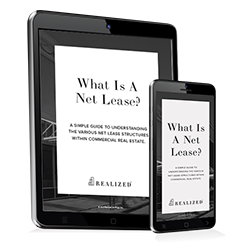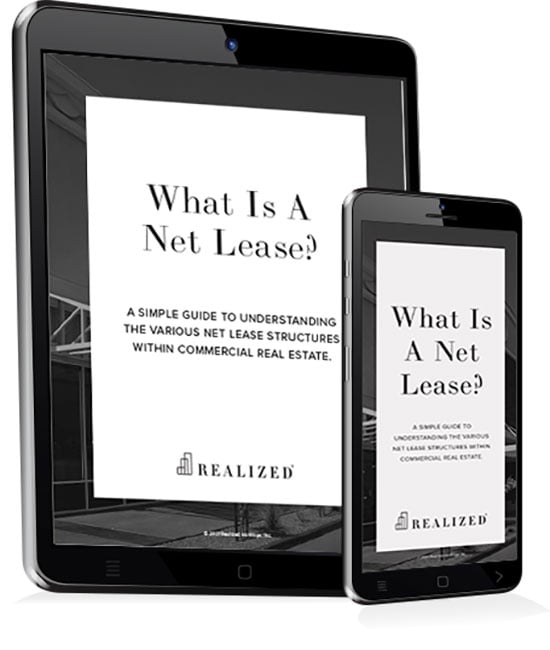
When it comes to commercial real estate investing, one of the most important aspects to understand is lease structures. As a concept, leasing may seem straightforward — your tenant occupies your asset and pays rental income. However, there are many kinds of leases out there, and some divide the expenses between the tenant and the landlord. These structures are called net leases.
The most common types of net leases are single net, double net, and triple net leases. Each one has its own distinct divisions of expenses, creating unique characteristics, advantages, and disadvantages. As an investor, you’ll want to understand the specific features of each to determine which structure works best for your investment needs.
Below, Realized 1031 shares a comprehensive guide to help you compare each type of net lease, including their pros and cons, and how market conditions impact them.
What Is a Net Lease?
A net lease, also called a single-tenant net lease (STNL), is a type of lease agreement where the tenant agrees to pay a net operating expense aside from the base rent. These net expenses can be property taxes, insurance premiums, or maintenance costs.
In contrast, the gross lease is the structure where the tenant only pays the base rent. The landlord or property owner will pay all the net operating costs. Gross leases are more common in residential properties or office arrangements. However, net leases are popular in commercial properties because they allow landlords to share the burden of property operations with tenants.
Aside from sharing the operating costs, investors also favor net leases because they can provide some level of protection in certain market conditions. Others prefer the reduced involvement in certain aspects of operations.
Single Net Lease
The first entry in our discussion is the lease agreement with the simplest structure: the single net lease, also known as an N lease. The only additional expense the tenant shoulders, aside from the base rent, is property tax in most cases. Rarely are N leases dedicated to insurance premiums or maintenance costs.
The N lease is the first step away from a gross lease, where the property owner pays for all net operating costs. As the lease shifts the property tax burden to the tenant, you can reduce your financial exposure, especially now that property taxes are rising.
Here’s a breakdown.
- Tenant Responsibility: Monthly rent + property taxes
- Landlord Responsibility: Insurance premiums + property maintenance costs (+ major capital expenses when necessary)
- Typical Lease Term: Most single-net lease agreements are for short-term tenants or smaller commercial properties. Some landlords use N leases as a stepping stone for tenants new to leasing, gradually preparing them for double or triple net structures.
Pros
- Appeals to Tenants Seeking Easier Payments: A single-net lease can be used to attract tenants who want to cover only one more type of expense. Property taxes, even though they’re rising, need to be paid on an annual or semi-annual basis, making them easier to manage.
- Offers Partial Risk-sharing: As landlords shift property taxes to tenants, you create some leeway to better manage more variable expenses like maintenance costs.
- More Control: As a statutory expense, property taxes aren’t directly involved with property operations. As such, even though you give up this particular responsibility, you still retain control over expenses involved directly in property operations.
- Steadier Cash Flow: With taxes handled by tenants, landlords enjoy more predictable net income.
Cons
- Higher Rent and Less Control for Tenants: Since an N lease only covers one net operating expense, tenants will still face higher rental rates compared to the latter two lease structures. Plus, they have less control over operations since you’re handling maintenance costs. These disadvantages may limit prospective tenants.
- Remaining Financial Risk: Insurance premiums are still variable, and maintenance costs are even more so. As market factors like inflation rise, these remaining net expenses can become a major source of financial burden.
- Management-heavy: Landlords must stay actively involved in property operations, unlike in triple net leases, where the tenant handles most costs. Those who want a more passive role in their investments may not find a single-net lease appealing or fit for their changing needs.
Double Net Lease
The next structure, which assigns a bit more responsibility to the tenant, is the double net lease. This arrangement is also called the NN lease, and it’s often recognized as a true middle ground for tenants and landlords. In an NN lease, the tenant pays the base rent, property taxes, and insurance premiums. Thanks to this model, there’s a better balance in financial responsibility compared to gross or N leases. However, it still isn’t as passive on the investor’s end as a triple net lease.
Double net leases are often the ideal choice in cases where the tenants need more flexibility over insurance coverage. By default, landlords pay for property insurance in gross or single net leases. However, this coverage may not be enough for certain needs. For example, a tenant operating a high-risk business, such as a laboratory or a manufacturing plant, may require more comprehensive coverage than a standard policy provides. A double net lease lets the tenant tailor their coverage to their unique operational needs.
Here’s a breakdown of the double net lease.
- Tenant Responsibility: Monthly rent + property taxes + insurance premiums
- Landlord Responsibility: Property maintenance costs (+ major capital expenses when necessary)
- Typical Lease Term: Double net leases are often used in multi-tenant properties, not just single ones. This arrangement allows tenants to have more flexibility over their coverage needs and offloads operational costs from landlords.
Pros
- Moderate Responsibility for Tenants: Compared to triple net leases, tenants won’t need to shoulder the highly variable costs of property maintenance. This benefit may make the property more appealing to tenants who want to avoid the unpredictability of structural maintenance.
- Reduced Expenses: As you pass both property taxes and insurance premiums to the tenant, you reduce your overall financial exposure.
- Maintain Property Oversight: NN leases still provide you with a high level of oversight over your asset. Maintenance works are the most involved aspect of property operations, giving you authority to ensure your building’s long-term value.
Cons
- Exposure to Rising Maintenance Costs: Like with gross and N leases, an NN lease keeps you exposed to variable costs of property maintenance needs. Higher expenses can leave you with reduced cash flow during periods of market volatility or in inflationary environments.
- Not a Completely Passive Structure: Maintenance works require an active role. As such, double net leases don’t provide the same level of hands-off management as triple net leases.
Triple Net Lease
The triple net lease, also known as the triple net lease, places the most financial responsibility on tenants. In this structure, the landlord relinquishes the duty of paying property taxes, insurance premiums, and maintenance costs. This leaves the tenant fully in control of the net operating expenses, and the landlord enjoys passive income.
A triple net lease is often preferred by investors who no longer want an active role in the management of their property. Examples are those who are entering retirement and want to spend more time enjoying their freedom instead of overseeing their commercial properties.
Triple net leases appeal to tenants who want full control over the real estate asset. These tenants are typically large national chains or single-location businesses with substantial operations. They often need to customize the property, so assuming maintenance costs help them keep the building up to industry standards or branding needs.
Here’s the breakdown.
- Tenant Responsibility: Property taxes + insurance premiums + maintenance costs
- Landlord Responsibility: No financial responsibility unless for major capital improvements or repairs
- Typical Lease Term: NNN leases often last 10 years or more, making them an appealing vehicle for passive investors. In addition, the property will usually have only one tenant, which provides a more straightforward arrangement.
Pros
- Passive Investment: As the tenant assumes the financial responsibility for three net operating expenses, you free yourself from hands-off involvement and enjoy truly passive income.
- Attracts High-quality Tenants: It’s usually tenants with large operations and established business models that look for properties with NNN leases. These include retail chains, healthcare companies, and hospitality businesses. They want full control of the property for consistency with branding and operations.
- Long-term Cash Flow: NNN leases can last for decades. This feature means investors can enjoy a steady income for long periods.
- Diversification: Given the type of tenants NNN leases attract, you could gain access to new markets or sectors that increase the diversification of your portfolio. Earning income from these other industries provides an additional cushion if some assets in your portfolio are underperforming.
Cons
- High Upfront Cost: NNN properties that can cater to the needs of sophisticated tenants are usually large and require significant capital upfront to acquire. Small-time investors may need to try other strategies, such as investing through a Delaware Statutory Trust (DST).
- Limited Flexibility: The decades-long lease terms may provide stable cash flow, but this also locks investors into one asset for a long time. If more promising opportunities arise, it would be difficult to exit the NNN lease.
- Loss of Control: Since the tenant has the most control over the asset, investors have a limited say over capital improvements that may improve net operating income.
Comparing Each Type of Net Lease
To summarize the differences of each net lease structure, here’s a simplified chart.
Single Net Lease
- Property Taxes: Tenant
- Insurance Premiums: Landlord
- Maintenance Costs: Landlord
Double Net Lease
- Property Taxes: Tenant
- Insurance Premiums: Tenant
- Maintenance Costs: Landlord
Triple Net Lease
- Property Taxes: Tenant
- Insurance Premiums: Tenant
- Maintenance Costs: Tenant
How Market Conditions Influence Each Type
Different market environments create certain conditions that affect each type of STNL. Here are some of these environments and how they influence the cash flow and risk levels of net lease variations.
Economic Volatility
Economic conditions are never set in stone, and the dynamic environment can result in unpredictability across all lease types. Strong economic conditions result in generally favorable effects, with tenants more comfortable assuming additional operating expenses. Meanwhile, economic downturns result in more wary or financially conservative tenants who prefer N leases since property taxes aren’t as affected.
Interest Rate Fluctuations
In terms of interest rate fluctuation, lower numbers usually result in more investors putting their capital in NNN properties. The predictable and passive income stream becomes especially attractive, and the lower interest rates help with debt management. Meanwhile, rising interest rates make N and NN leases more popular because they can offer more competitive rental agreements.
Tax and Insurance Trends
Local property tax hikes or surging insurance premiums can heavily influence lease desirability. Tenants may push back against triple net leases if these costs become volatile or burdensome. In such cases, landlords may negotiate double net leases, sharing in certain risks to keep long-term tenants happy and leases sustainable.
Inflation
Inflationary environments make NNN leases more popular to investors than other net leases, particularly because of rent escalation. The caveat is that tenants are less likely to enter this lease structure due to the volatile costs of goods and services.
Supply and Demand
The supply and demand for commercial properties for rent also affect net lease appeal. In environments with high demand and low vacancy rates, investors tend to prefer NNN leases since tenants are more likely to stay for the long term. Meanwhile, in markets with heightened supply and lowered demand, tenants prefer N or NN leases since they have more bargaining power and want fewer financial responsibilities.
Choosing the Right Lease Structure
Given the pros and cons of each net lease and how they perform under certain market conditions, it becomes apparent that each variation fits certain types of investors, especially with regard to their individual risk tolerance, income goals, and overall investment strategy.
- Single Net Lease: The N lease is ideal for those who want to remain involved with their property. Offloading taxes to the tenant provides some financial relief while you continue direct oversight of property management, insurance coverage, and maintenance needs.
- Double Net Lease: This arrangement creates the perfect middle ground for an investor who still wants some involvement over their asset while avoiding as much financial burden as possible.
- Triple Net Lease: The NNN lease is ideal for investors who want a truly passive income stream. Since tenants cover nearly all expenses, landlords enjoy a more predictable return.
In summary, there is no one-size-fits-all net lease structure. You must carefully consider your desired level of control, risk exposure, and long-term stability.
Acquiring a Net Lease Property Through 1031 Exchanges
Net lease properties can be acquired through various methods, with direct property ownership as the most straightforward option. A 1031 exchange is a kind of tax-advantaged transaction you can use to enter a net lease property. If you already own an asset that’s held for investment or business use, then you can swap that for a net lease property and defer capital gains taxes.
The traditional 1031 exchange results in direct ownership. However, there are variations to this transaction that can help you access commercial real estate through indirect ownership. One method is the aforementioned DST, which is eligible for 1031 exchanges. You acquire beneficial interests in the DST from the sale of your relinquished property, and you earn monthly income proportional to these interests.
One additional benefit of DSTs is that they allow you to access income from NNN properties, which are usually out of reach for small-time investors, given the high upfront costs. DSTs pool money from several investors, allowing them to create a portfolio of institutional-grade assets that may include an NNN property.
Wrapping Up: Comparing the Three Types of Single-Tenant Net Leases
Single, double, and triple net leases each have distinct features, advantages, and trade-offs that investors must understand before committing to a net lease investment. From the modest financial relief of N leases to the hands-off involvement offered by NNN leases, each structure presents benefits that make it appealing to certain types of investors. Careful evaluation of these characteristics, particularly their impact on your risk exposure and long-term goals, is crucial to increasing the chances of success.
Sources:
https://www.investopedia.com/terms/n/net-lease.asp
https://www.newsweek.com/america-property-tax-headache-2065595



